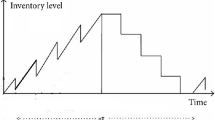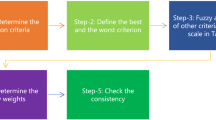Abstract
Inspection activities in automotive manufacturing play a crucial role in diagnosing and preventing unexpected failures by adopting the well-planned intervals. However, finding the optimal inspection intervals has been a major concern within manufacturing systems due to the failure dependency issue caused by the design complexity and integrated operations. Hence, this paper proposes a new framework for inspection interval optimization under failure dependency in three steps; firstly identifying all failure modes and potential dependent failures through Failure Mode and Effect Analysis (FMEA) method, secondly, adapting the statistical based approach for reliability and availability evaluation, as well as using the Bayesian theory for availability and total expected cost based inspection modeling under failure dependency and finally, performing some well-known Multi-Criteria Decision-Making (MCDM) techniques for finding the optimal trade-off between main criteria e.g. total expected cost and reliability indices. The results of the proposed framework revealed that the failure dependency has a meaningful impact on inspection intervals. Besides, the cost-based model suggests shorter inspection intervals with that of the availability-based model in all dependent failure cases. As a consequence, the results could be useful for implementing the reliable maintenance programs to improve the operational performance of complex equipment in automotive manufacturing.
Zusammenfassung
Inspektionstätigkeiten in der Automobilherstellung spielen eine entscheidende Rolle bei der Diagnose und Vermeidung unvorhergesehener Ausfälle durch die Anwendung gut geplanter Intervalle. Allerdings ist die Bestimmung der optimalen Inspektionsintervalle in Produktionssystemen aufgrund der Fehlerabhängigkeit ein wesentliches Thema, das durch die Komplexität der Konstruktion und die integrierten Prozesse verursacht wird. Deshalb bietet diese Veröffentlichung einen neuen Mechanismus zur Optimierung von Inspektionsintervallen unter Berücksichtigung der Fehlerabhängigkeit in drei Schritten: zunächst Identifikation aller Fehlerarten und möglichen abhängigen Fehler durch die Methode FMEA (Failure Mode and Effect Analysis), zweitens die Anpassung des statistischen Ansatzes für die Zuverlässigkeits- und Verfügbarkeitsanalyse sowie die Verwendung der Bayes’schen Theorie für die Modellierung der Verfügbarkeit und der erwarteten Gesamtkosten bei der Inspektion unter Beachtung der Fehlerabhängigkeit und zum Schluss die Umsetzung verschiedener bekannter MCDM-Techniken (Multi-Criteria Decision-Making) zur Erkennung des optimalen Kompromisses zwischen den Hauptkriterien, z. B. den erwarteten Gesamtkosten und den Zuverlässigkeitsindizes. Die Ergebnisse des vorgestellten Konzepts zeigten, dass die Fehlerabhängigkeit einen deutlichen Einfluss auf die Inspektionsintervalle aufweist. Daneben empfiehlt das kostenorientierte Modell kürzere Inspektionsintervalle im Vergleich zu dem verfügbarkeitsorientierten Modell in allen abhängigen Fehlerfällen. Aus diesem Grunde liefern die Ergebnisse wichtige Hinweise zur Umsetzung von zuverlässigen Wartungsprogrammen, um die Betriebsleistung komplexer Geräte in der Automobilproduktion zu verbessern.









Similar content being viewed by others
References
Soltanali H, Garmabaki AHS, Thaduri A, Parida A, Kumar U, Rohani A (2019) Sustainable production process: an application of reliability, availability, and maintainability methodologies in automotive manufacturing. Proc Inst Mech Eng Part O J Risk Reliab 233(4):682–697
Li W, Pham H (2005) An inspection-maintenance model for systems with multiple competing processes. IEEE Trans Reliab 54(2):318–327
Ye Z, Cai Z, Zhou F, Zhao J, Zhang P (2019) Reliability analysis for series manufacturing system with imperfect inspection considering the interaction between quality and degradation. Reliab Eng Syst Saf 189:345–356
Van Horenbeek A, Pintelon L, Muchiri P (2010) Maintenance optimization models and criteria. Int J Syst Assur Eng Manag 1(3):189–200
Bal A, Satoglu SI (2018) Mathematical optimization models for the maintenance policies in production systems. In: Handbook of research on applied optimization methodologies in manufacturing systems. IGI Global, , pp 252–268
Rezaei E (2017) A new model for the optimization of periodic inspection intervals with failure interaction: a case study for a turbine rotor. Case Stud Eng Fail Anal 9:148–156
Golmakani HR, Moakedi H (2012) Periodic inspection optimization model for a two-component repairable system with failure interaction. Comput Ind Eng 63(3):540–545
Sheu SH, Chen YC, Wang WY, Shin NH (2003) Economic optimization of off-line inspection with inspection errors. J Oper Res Soc 54(8):888–895
Mathew S (2004) Optimal inspection frequency: a tool for maintenance planning/forecasting. Int J Qual Reliab Manag 21:763–771
Wang W (2009) An inspection model for a process with two types of inspections and repairs. Reliab Eng Syst Saf 94(2):526–533
Barker CT, Newby MJ (2009) Optimal non-periodic inspection for a multivariate degradation model. Reliab Eng Syst Saf 94(1):33–43
de Almeida AT (2012) Multicriteria model for selection of preventive maintenance intervals. Qual Reliab Eng Int 28(6):585–593
Ahmadi A, Kumar U (2011) Cost based risk analysis to identify inspection and restoration intervals of hidden failures subject to aging. IEEE Trans Reliab 60(1):197–209
Babishin V, Taghipour S (2016) Optimal maintenance policy for multicomponent systems with periodic and opportunistic inspections and preventive replacements. Appl Math Model 40(23–24):10480–10505
Jafary B, Nagaraju V, Fiondella L (2017) Impact of correlated component failure on preventive maintenance policies. IEEE Trans Reliab 66(2):575–586
Garmabaki AHS, Ahmadi A, Ahmadi M (2016) Maintenance optimization using multi-attribute utility theory. In: Current trends in reliability, availability, maintainability and safety. Springer, Cham, pp 13–25
de Almeida AT, Bohoris GA (1996) Decision theory in maintenance strategy of standby system with gamma-distribution repair-time. IEEE Trans Reliab 45(2):216–219
Brito AJ, de Almeida AT (2009) Multi-attribute risk assessment for risk ranking of natural gas pipelines. Reliab Eng Syst Saf 94(2):187–198
de Almeida AT (2001) Multicriteria decision making on maintenance: spares and contracts planning. Eur J Oper Res 129(2):235–241
Garmabaki AHS, Ahmadi A, Mahmood YA, Barabadi A (2016) Reliability modelling of multiple repairable units. Qual Reliab Eng Int 32(7):2505–2517
Bukhsh AZ, Stipanovic I, Klanker G, O’Connor A, Doree AG (2019) Network level bridges maintenance planning using Multi-Attribute Utility. Theor Struct Infrastructure Eng 15(7):872–885
Ahmadi A, Gupta S, Karim R, Kumar U (2010) Selection of maintenance strategy for aircraft systems using multi-criteria decision making methodologies. Int J Reliab Qual Saf Eng 17(03):223–243
Chakraborty S (2011) Applications of the MOORA method for decision making in manufacturing environment. Int J Adv Manuf Technol 54(9):1155–1166
Yang JH, Han MY, Zuo QW (2019) Research on optimizing model of single-unit system inspection interval based on RAMS and TOPSIS. In: 2019 International Conference on Quality, Reliability, Risk, Maintenance, and Safety Engineering (QR2MSE). IEEE, , pp 1088–1095
Soltanali H, Rohani A, Tabasizadeh M, Abbaspour-Fard MH, Parida A (2020) An improved fuzzy inference system-based risk analysis approach with application to automotive production line. Neural Comput Appl 32(14):10573–10591
Soltanali H, Rohani A, Abbaspour-Fard MH, Farinha JT (2021) A comparative study of statistical and soft computing techniques for reliability prediction of automotive manufacturing. Appl Soft Comput 98:106738
AGRAMKOW Co. (2014) Manual instructions of line-side Brake fluid filling equipment. Augustenborg Landevej 19DK-6400 Sønderborg, Denmark. https://www.agramkow.com. Accessed 11 Mar 2021
Stamatelatos M, Dezfuli H, Apostolakis G, Everline C, Guarro S, Mathias D, Youngblood R (2011) Probabilistic risk assessment procedures guide for NASA managers and practitioners. https://doi.org/10.13140/RG.2.2.18206.13122
Louit DM, Pascual R, Jardine AK (2009) A practical procedure for the selection of time-to-failure models based on the assessment of trends in maintenance data. Reliab Eng Syst Saf 94(10):1618–1628
Barabady J, Kumar U (2008) Reliability analysis of mining equipment: a case study of a crushing plant at Jajarm bauxite mine in Iran. Reliab Eng Syst Saf 93(4):647–653
Kumar U, Klefsjö B (1992) Reliability analysis of hydraulic systems of LHD machines using the power law process model. Reliab Eng Syst Saf 35(3):217–224
Garmabaki AHS, Ahmadi A, Block J, Pham H, Kumar U (2016) A reliability decision framework for multiple repairable units. Reliab Eng Syst Saf 150:78–88
Soltanali H, Rohani A, Tabasizadeh M, Abbaspour-Fard MH, Parida A (2020) Operational reliability evaluation-based maintenance planning for automotive production line. Qual Technol Quant Manag 17(2):186–202
Tsarouhas PH (2015) Maintainability analysis in the yogurt industry. Int J Syst Assur Eng Manag 6(2):119–128
Department of Defense (1981) Department of defense handbook reliability growth management. MIL-HDBK-189. Department of Defense, Washington DC
Jardine AK, Tsang AH (2005) Maintenance, replacement, and reliability: theory and applications. CRC press,
Blanchard BS, Fabrycky WJ, Fabrycky WJ (1990) Systems engineering and analysis vol 4. Prentice hall, Englewood Cliffs
Kanoun K, de Bastos Martini MR, De Souza JM (1991) A method for software reliability analysis and prediction application to the TROPICO‑R switching system. IEEE Trans Softw Eng 17(4):334
Huang W, Dietrich DL (2005) An alternative degradation reliability modeling approach using maximum likelihood estimation. IEEE Trans Reliab 54(2):310–317
Ruschel E, Santos EAP, Loures EDFR (2020) Establishment of maintenance inspection intervals: an application of process mining techniques in manufacturing. J Intell Manuf 31(1):53–72
Kallen MJ, Van Noortwijk JM (2005) Optimal maintenance decisions under imperfect inspection. Reliab Eng Syst Saf 90(2–3):177–185
Flage R, Coit DW, Luxhøj JT, Aven T (2012) Safety constraints applied to an adaptive Bayesian condition-based maintenance optimization model. Reliab Eng Syst Saf 102:16–26
Yazdi M, Soltanali H (2019) Knowledge acquisition development in failure diagnosis analysis as an interactive approach. Int J Interact Des Manuf 13(1):193–210
Yazdi M, Daneshvar S, Setareh H (2017) An extension to fuzzy developed failure mode and effects analysis (FDFMEA) application for aircraft landing system. Saf Sci 98:113–123
Cahyapratama A, Sarno R (2018) Application of analytic hierarchy process (AHP) and simple additive weighting (SAW) methods in singer selection process. In: 2018 International Conference on Information and Communications Technology (ICOIACT). IEEE, , pp 234–239
Brauers WK, Zavadskas EK (2006) The MOORA method and its application to privatization in a transition economy. Control Cybern 35(2):445–469
Zavadskas EK, Kalibatas D, Kalibatiene D (2016) A multi-attribute assessment using WASPAS for choosing an optimal indoor environment. Arch Civ Mech Eng 16(1):76–85
Funding
The authors gratefully acknowledge the financial support from the Ferdowsi University of Mashhad, Iran (No. FUM-52316), which has been research project.
Author information
Authors and Affiliations
Corresponding author
Ethics declarations
Conflict of interest
H. Soltanali, M. Khojastehpour, E. Rezaei and A. Rohani declare that they have no competing interests.
Rights and permissions
About this article
Cite this article
Soltanali, H., Khojastehpour, M., Rezaei, E. et al. Inspection interval optimization for complex equipment in automotive manufacturing under dependent failures. Forsch Ingenieurwes 86, 105–122 (2022). https://doi.org/10.1007/s10010-021-00568-6
Received:
Accepted:
Published:
Issue Date:
DOI: https://doi.org/10.1007/s10010-021-00568-6




